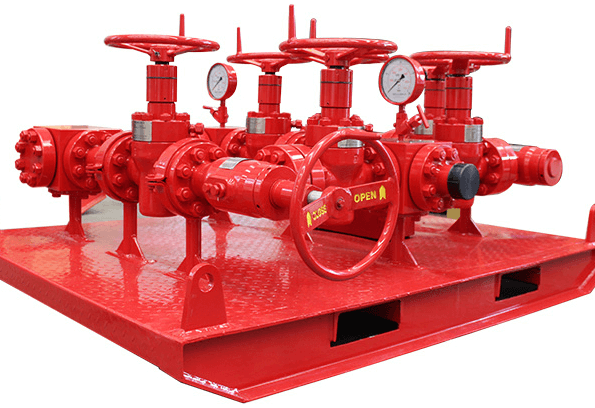What Does
Choke Manifold Mean?
A choke manifold is an arrangement of piping and valves with adjustable choke valves. This assembly is primarily responsible for controlling flows and pressures in various industrial applications, such as onshore and offshore well testing and production operations. By implementing a choke manifold, operators and asset owners can adjust the flows and pressures that enter processing equipment, thus controlling production and minimizing equipment damage.
The most important element of the choke manifold is the assembly of choke valves. These valves are designed specifically to restrict flow when needed (hence the term choke). By adjusting these valves as needed, flows can be regulated as required.

Figure 1: Illustration showing a sectional view of a choke valve (source)
Some of the most common ancillary equipment that can be found on a typical choke manifold include choke boxes, pressure sensors, pressure sampling ports, thermowells to monitor pressure, temperature, and other fluid properties.
In the oil and gas industry, for example, choke manifolds are used to lower pressure from the wellhead to allow retrieved gases to be flared on-site. In this application, more than one choke valve is used to keep the choke manifold functional at all times.
Trenchlesspedia Explains Choke Manifold

Figure 2: Typical choke valve assembly (source)
While choke manifolds are commonly found in the oil and gas industry, they are also used in the trenchless industry during drilling operations that involve the use of drilling mud (also known as drilling fluid). Firstly, the manifold can be used to control the pressures of the drilling fluid ejected at the cutting head. During recirculation, the mud is also circulated through the choke manifold when the blowout preventer is closed.
During well testing, choke manifolds allow flows and pressures to be controlled when testing downstream components. As previously mentioned, choke manifolds typically consist of more than one choke valve. In most cases, these extra valves are provided for redundancy. In other words, if one choke valve on the manifold fails or has to be taken out of service, fluid flows can be redirected to the other valves.
What Are Some of the Main Functions of a Choke Manifold?
In addition to being used for flow and pressure control, choke manifolds also serve several other essential functions, including:
-
Improving overall process safety around the site.
-
Maintaining flow rates required for testing. For example, some tests may require different flow rates over various time periods.
-
In some applications, choke manifolds may also prevent sand or other materials from entering the well by limiting the flow rate. By reducing the flow rate and flow speed, operators can minimize the quantity of debris entering the well.
-
Ensuring that the flow is critical. In other words, the manifold ensures that pressure fluctuations downstream of the manifold do not affect the downhole pressure and flow rate at the well.